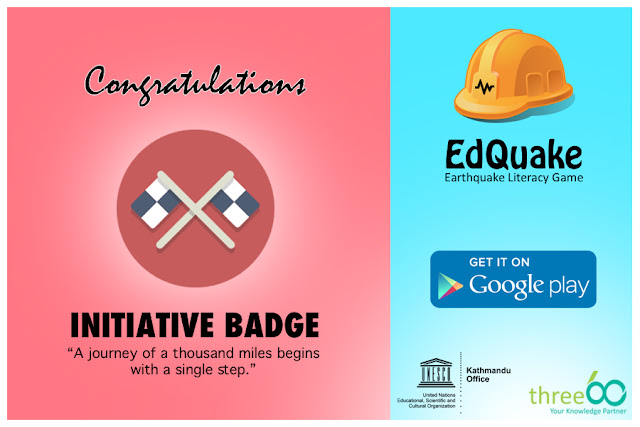![]()
The objective of the game was to use texts, audios, videos, badges, quizzes, points, stories and characters to educate users on preparation for earthquake and decision making during and after earthquake.
Application Description
Before the game starts, a teaser video is played where an event of earthquake is shown inside a home scenario. The video is shown in order to reflect the importance of earthquake preparedness. The video can be skipped the next time as per the choice of the player.
Application Home Screen
The application home screen allows users to start a new game, resume from where they left off previously, change game settings such as sound and language settings and submit their score to leaderboards, and quit the application. It also displays current user name and character selection along with all the badges that the user has won.
Starting a new game
Upon starting a new game, a dialog appears where the user enter his/her name and selects a character. The user can choose two characters that of a boy or a girl in order to play the game. These characters will also act as protagonists in animated stories.
Badges
Badges are provided to users upon completion of a milestone or a level. The badges provides an incentive for the players and makes the game more engaging and interesting.
PSA and Video Activities
Engines have been setup to support audio and video activities.
The radio can be used as an informative element in the game. For example:
A PSA for earthquake preparation informing about vital items one needs in their emergency backpack can be played in the radio.
The video platform can support a series of storytelling addressing to different type of circumstances and safety tips regarding the effects of earthquake. Nepali subtitles also appear on the bottom of each videos.
Drag and Drop Activity
Engines have been setup to support drag and drop activities.
Based on this drag and drop engine we have developed relevant games. For example:
Preparing a GoBag
Following the PSA, the users are required to drag and drop items from a set of vital items (such as first aid kid) and useless items (such as toys) to their backpack. Since the backpack can only hold a certain number of items, the users will have to optimize for best preparation. Upon completion, the app lets the users know if their selection is correct.
Similarly, the app will let the users know if their selection was wise. In case of wrong selection, the app will also let the users know why their selection was incorrect. Unlike other quiz activities, the difference here is that the users will still be allowed to go back to change their answer. The rationale was to follow a formative teaching approach.
Quiz Engines
Engines have been setup to support quiz platform.
Quizzes produces better organization of knowledge by helping the brain organize material in clusters to allow better retrieval. It also identifies gap in knowledge and lets people know what is learned and what is not.
The quiz engines supports quiz games which can be very informative. The answers chosen can also lead to some consequent information or videos later.
There are four different types of quiz questions.
- Grid Select
- True and False
- Multiple Choice Questions (3 Options)
- Multiple Choice Questions (4 Options)
The first two types of questions carry a marking rubric of 200 points. The user receives complete points if he/she answers it correctly in the first go. The point a user can collect from each quiz is reduced depending on the number of mistakes.The third question carry a marking rubric of 300 points and the fourth question carry a marking rubric of 400 points. Similarly, depending on the mistakes, the point is reduced. The result is displayed with additional tip information and graphics.
Example 1: Grid Quiz Activity
Example 2: Multiple Choice Quiz Activity (3 options)
Leaderboards and Facebook sharing
The application will allow users to submit their points to a global leaderboards system. This will allow users to compete with other players.
